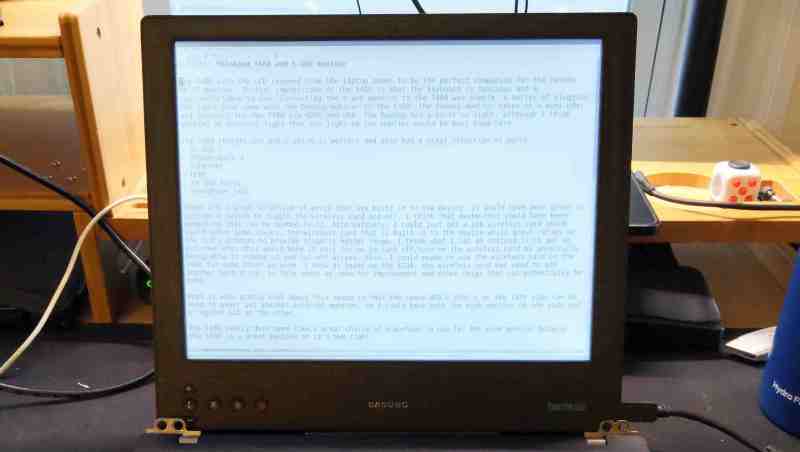[Alexander Soto] prefers the reduced eye-strain of an e-ink display, but he doesn’t have a portable solution to use at different work stations. The solution? Make your own e-ink laptop. Once you see his plan, it’s not as crazy as it sounds.
[Alexander] got his inspiration from an earlier Dasung Paperlike Pro teardown that we covered back in 2018. His plan is to shoehorn the e-ink panel into a “headless” Thinkpad T480 laptop. This particular model ES133TT3 display is 13.3 inches (about 40 cm) with a much-better-than-normal laptop resolution of 2200 x 1650 pixels. It is driven over HDMI and is perfect fit for the Thinkpad enclosure.
Unfortunately, these displays haven’t gone down in price since 2018. They’re still in the $1000+ price range, more expensive than many laptops. But if you really want the reduced eye-strain of e-ink in a laptop format, you’re going to have to shell out for it.
It’s a pretty ambitious project. We’re looking forward to following his progress and see how the finished laptop goes together. Do check out the extensive list of e-ink references on his project page, too. If you want to experiment with a less expensive e-ink project, have a look at the PaperTTY project for your Raspberry Pi.
















I swapped a laptop display to e-ink some years ago so I could use it outdoors in sunny weather. Worked great except it turns out sun bathing is more relaxing than using a computer once you are finally outdoors.
Yes, and the laptop blocks part of your body from soaking in the rays!
B^)
You can always tell the nerds by the pasty white patch in their mid-section. :-)
The active matrix LCD in the original Macintosh Portable was extremely good in direct sunlight. But yeah, same problem with sunbathing being more fun than System 6.
He went to all this trouble, and he didn’t post even a single decent picture of his results?
It’s a work in progress. What pictures would you like to see? In another post, I have a teardown of the e-ink panel with pictures and a video.
https://alexsoto.dev/dasung-paperlike-hdft-teardown.html
I want to see how is the e-ink lenovo laptop but pricetag is too high :D
https://www.engadget.com/lenovo-thinkbook-plus-gen-2-i-e-ink-screen-laptop-170048754.html?guccounter=1&guce_referrer=aHR0cHM6Ly93d3cuZ29vZ2xlLmNvbS8&guce_referrer_sig=AQAAAB6yR9P8osQOTF9CAZTZEqe11eZGC2ex-tPivi0iI8df-EKf331N73bkSnpNCzq_y52dGkHKzfDuRLY39c6vD_ZOu_LNQ8VEsd1b-rV1Vd6LT6hsS6Y7lDtRAGXs3gHg4mCRavPf7a9n5CFbs-uTsE89-ZvoRHhv0h0NHfMyXZPh
But if screen 1000$+ then maybe this laptop is still better choice.
But why other displays silently dies out, Bridgestone AeroBee, Mirasol display or ClearInk
The Thinkbook Plus Gen 2 and Yoga Book C930 could be possible options. From what I’ve researched, the Yoga Book C930 e-ink screen could be set to extended mode and allow you to run standard applications. I prefer the Dasung panels in my experience.
Are there smaller, “edgeless” displays available that could be combined to make a larger screen?
There’s been a conversation about this, https://forum.ei2030.org/t/tile-multiple-small-eink-screens-to-make-a-cheaper-big-screen/131/3
The problem seems to be the separation and data transfer speed when using multiple smaller screens.
From the description, the Waveshare panel is very well tiled. The separation mentioned is that one subpanel updates slightly later than another, which if you’re working with eink isn’t likely to be the first thing to upset you; you shouldn’t be updating it frequently, particularly for a multicolor panel (enjoy that 16 second refresh time). With some creativity you could probably make them update simultaneously anyway, e.g. using QSPI, I2S or PIO peripherals on ESP32 or RP2040, or even a small CPLD. E-radionica seem to have been really good about publishing source for their Inkplate displays.
e-paper has a purposely exorbitant price. Nothing about it is expensive but the company that owns the patents is ensuring prices remain absurdly high so that they can bilk you for as much money as possible. This will be a great technology when the patent expires but until then it’s just overpriced garbage.
Which patents specifically? The original patents – which were filed in 1996 and 1997 – are already expired.
(I’ve checked the patent’s dates on Wikipedia’s E_Ink page.)
To me, they were only ever a solution to the sucktastic LCDs we had in the late 90s, which LCDs were somewhat improved in the early noughties, and vastly improved yearly from ~2005 onwards, while e-ink and e-paper have languished in minimum viable product status ever since, improvements in them being not very obvious. I would think with patents expired, we’ll soon see better range of grey scales, higher refresh rates when something is changing, and better pricing. Which if they’d done 10 years ago, might have given them a market beyond the nichey niche they’ve dug themselves into.
I’d like to point out something that’s kind of hidden within Alex’s reply above. He has founded the EI2030 working group “to iterate, test, document, develop, generate interest, and make public our work of creating a laptop using e-ink or similar non-emissive technology”. For those of you passionate about e-ink display applications, check out the forums at https://forum.ei2030.org
You wouldn’t want E Ink for fully interactive displays. Kindle is a good fit because you can tolerate page turns, but the inherently slow refresh is painful for input tasks
The “One Laptop Per Child” project had a really cool screen. Passive, sunlight readable monochrome for daylight use at a high resolution and low power. The _same screen_ could also work as a backlit colour acreen at night or if the user really needed colour. If there was a modern device that used this screen I would buy it right now.
Mirasol is better than e-ink